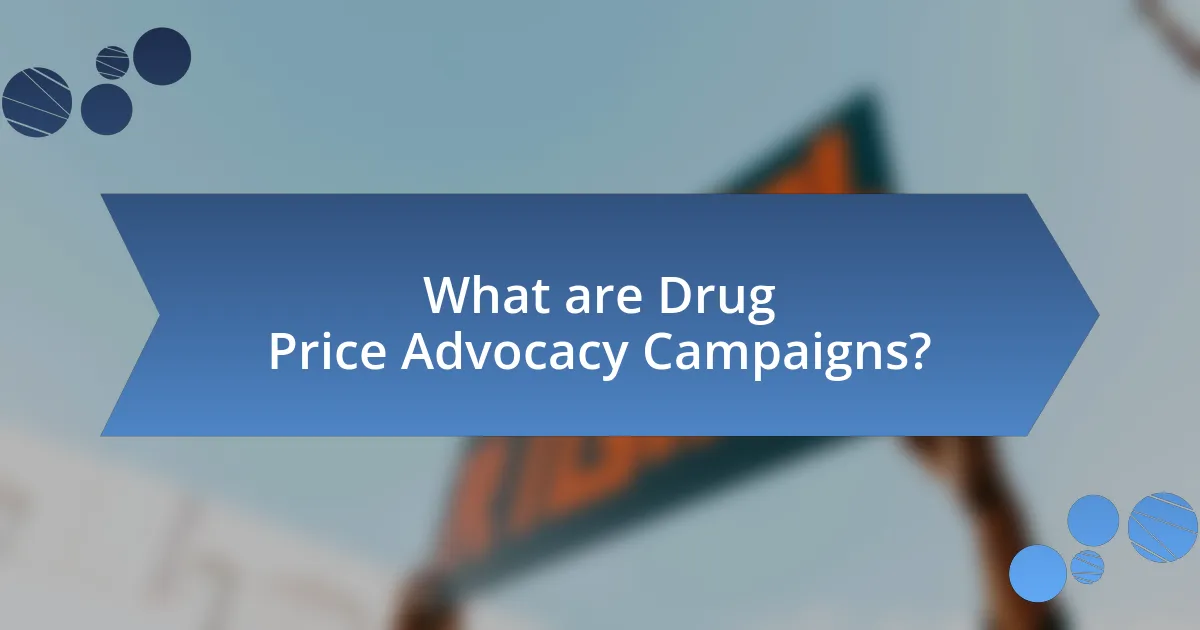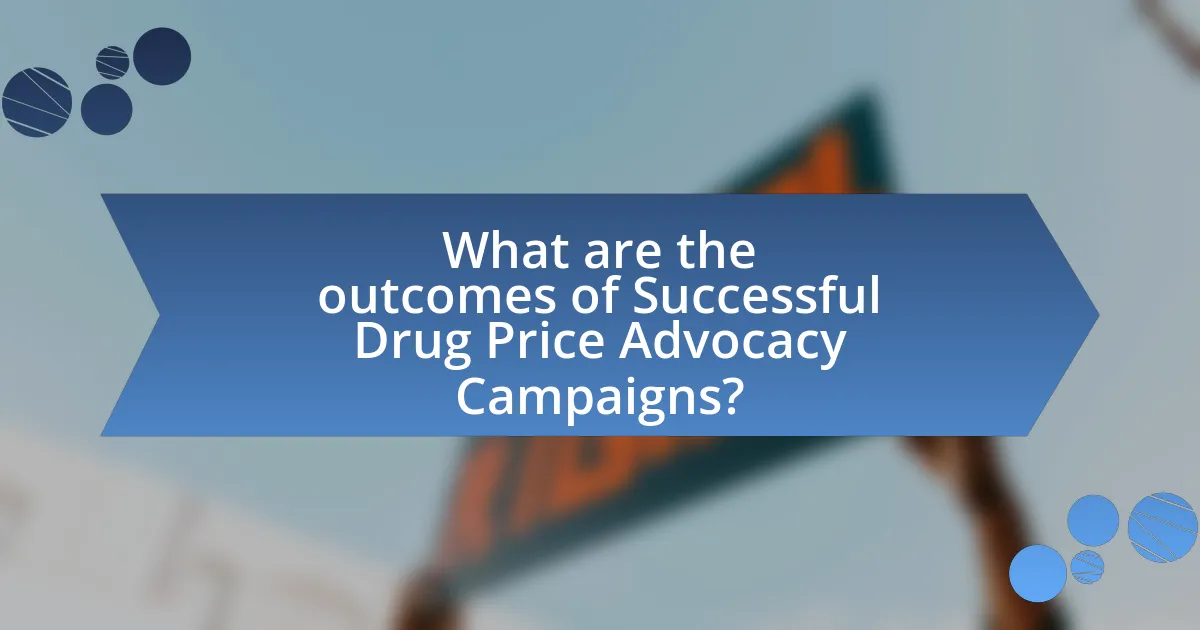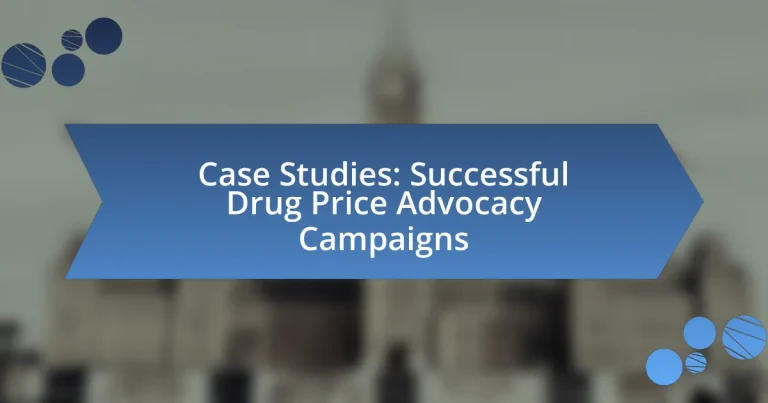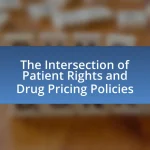Drug price advocacy campaigns are organized efforts aimed at influencing pharmaceutical pricing policies to promote affordable access to medications. These campaigns involve various stakeholders, including patients, healthcare professionals, and advocacy groups, and have demonstrated effectiveness in raising awareness and lobbying for legislative changes. The article examines the importance of these campaigns in reducing medication costs, enhancing healthcare access, and influencing public policy, while also highlighting successful case studies such as the “Campaign for Affordable Medicines” and “Patients for Affordable Drugs.” Additionally, it discusses the strategies employed in these campaigns, the challenges faced, and the outcomes achieved, providing insights into best practices for future advocacy efforts.

What are Drug Price Advocacy Campaigns?
Drug price advocacy campaigns are organized efforts aimed at influencing policies and practices related to the pricing of pharmaceuticals. These campaigns typically involve stakeholders such as patients, healthcare professionals, and advocacy groups who seek to promote affordable access to medications. For instance, campaigns like “Patients for Affordable Drugs” have successfully raised awareness about high drug prices and lobbied for legislative changes, demonstrating the effectiveness of collective action in addressing this issue.
Why are Drug Price Advocacy Campaigns important?
Drug price advocacy campaigns are important because they aim to reduce the cost of medications, making them more accessible to patients. These campaigns highlight the financial burden that high drug prices impose on individuals and healthcare systems, advocating for policy changes and pricing transparency. For instance, a study by the House of Representatives in 2020 indicated that nearly one in four Americans reported not filling a prescription due to cost, underscoring the need for advocacy efforts to address affordability. By mobilizing public support and influencing legislation, these campaigns can lead to significant reforms that enhance patient access to essential medications.
What impact do these campaigns have on healthcare access?
Advocacy campaigns focused on drug pricing significantly enhance healthcare access by lowering medication costs and increasing affordability for patients. For instance, campaigns that successfully negotiated price reductions for essential medications have led to improved access for low-income populations, as evidenced by the 2019 campaign that resulted in a 30% price drop for insulin, allowing more patients to afford their necessary treatments. These initiatives not only alleviate financial burdens but also promote equitable healthcare access, as demonstrated by studies showing that reduced drug prices correlate with higher medication adherence rates among previously underserved communities.
How do they influence public policy and pharmaceutical pricing?
Advocacy groups influence public policy and pharmaceutical pricing by mobilizing public opinion, lobbying lawmakers, and raising awareness about drug affordability. These organizations often conduct research and disseminate data that highlight the impact of high drug prices on patients and healthcare systems, which can lead to legislative changes. For example, the advocacy group Patients for Affordable Drugs has successfully campaigned for policies that promote transparency in drug pricing and support the negotiation of lower prices for Medicare. Their efforts have contributed to increased public pressure on policymakers to address the rising costs of medications, resulting in legislative proposals aimed at regulating pharmaceutical prices.
What strategies are commonly used in Drug Price Advocacy Campaigns?
Common strategies used in Drug Price Advocacy Campaigns include grassroots mobilization, coalition building, public awareness campaigns, and legislative lobbying. Grassroots mobilization involves engaging community members to raise awareness and pressure decision-makers, while coalition building brings together various stakeholders, such as patient groups, healthcare providers, and advocacy organizations, to strengthen the campaign’s impact. Public awareness campaigns utilize media and social platforms to inform the public about drug pricing issues, fostering a sense of urgency and collective action. Legislative lobbying focuses on influencing policymakers to enact laws that promote fair pricing and access to medications. These strategies have been effective in various campaigns, such as the “Campaign for Affordable Medicines,” which successfully advocated for lower drug prices through a combination of these approaches.
How do grassroots movements contribute to these campaigns?
Grassroots movements significantly contribute to drug price advocacy campaigns by mobilizing community support and raising awareness about pricing issues. These movements often engage individuals directly affected by high drug costs, creating a collective voice that can influence policymakers. For instance, organizations like Patients for Affordable Drugs have successfully organized campaigns that highlight personal stories of those struggling with medication costs, which can sway public opinion and legislative action. Additionally, grassroots efforts can leverage social media to amplify their message, reaching a broader audience and fostering a sense of urgency around the need for reform. This combination of personal narratives and widespread outreach has proven effective in driving change in drug pricing policies.
What role do social media and digital platforms play?
Social media and digital platforms serve as critical tools for advocacy in drug price campaigns by facilitating communication, mobilizing support, and disseminating information. These platforms enable organizations to reach a broad audience quickly, allowing for the rapid sharing of campaign messages and updates. For instance, a study by the Pew Research Center found that 69% of adults in the U.S. use social media, highlighting its potential to engage a significant portion of the population in advocacy efforts. Additionally, digital platforms allow for targeted outreach, enabling campaigns to connect with specific demographics that are most affected by drug pricing issues. This targeted approach can enhance the effectiveness of advocacy strategies, as seen in campaigns that successfully utilized social media to rally public support and influence policy changes.
What are some notable examples of successful Drug Price Advocacy Campaigns?
Notable examples of successful drug price advocacy campaigns include the “Campaign for Affordable Medicines” led by the Treatment Action Campaign in South Africa, which successfully pressured the government to provide antiretroviral drugs at lower prices during the HIV/AIDS crisis. This campaign resulted in a significant reduction in drug costs, making treatment accessible to millions. Another example is the “Patients for Affordable Drugs” initiative in the United States, which has effectively lobbied for legislative changes to lower prescription drug prices, including the introduction of the Affordable Drug Pricing Act. These campaigns demonstrate the power of advocacy in influencing drug pricing policies and improving access to essential medications.
What lessons can be learned from these case studies?
The lessons learned from successful drug price advocacy campaigns include the importance of strategic collaboration, effective communication, and data-driven approaches. Strategic collaboration among stakeholders, such as patient advocacy groups, healthcare professionals, and policymakers, enhances the campaign’s credibility and reach. Effective communication ensures that the message resonates with the public and decision-makers, as seen in campaigns that utilized clear narratives and personal stories to highlight the impact of high drug prices. Data-driven approaches, including the use of statistics and case examples, provide compelling evidence that can influence policy changes and public opinion, as demonstrated in campaigns that successfully reduced drug prices through well-researched arguments and public engagement.
How did these campaigns mobilize support and resources?
These campaigns mobilized support and resources through strategic grassroots organizing, effective use of social media, and collaboration with influential stakeholders. Grassroots organizing involved engaging community members to raise awareness about drug pricing issues, which fostered a sense of urgency and collective action. Social media platforms were utilized to disseminate information rapidly, allowing campaigns to reach a wider audience and galvanize public support. Collaborations with healthcare professionals, patient advocacy groups, and policymakers provided additional credibility and resources, amplifying the campaigns’ messages and increasing their impact. For instance, the “Patients Over Pharma” campaign successfully united various stakeholders to advocate for legislative changes, demonstrating the effectiveness of these mobilization strategies.

How do Successful Drug Price Advocacy Campaigns operate?
Successful drug price advocacy campaigns operate by mobilizing stakeholders, leveraging data, and employing strategic communication to influence policy changes. These campaigns often involve collaboration among patient advocacy groups, healthcare professionals, and policymakers to highlight the impact of high drug prices on public health. For instance, the campaign led by the organization Patients for Affordable Drugs utilized comprehensive research to demonstrate the financial burden of prescription medications, which garnered significant media attention and legislative support. This approach is validated by the fact that campaigns that effectively combine grassroots mobilization with data-driven advocacy have been shown to achieve measurable policy outcomes, such as price negotiations and increased transparency in drug pricing.
What are the key components of a successful campaign?
The key components of a successful campaign include clear objectives, targeted messaging, strategic planning, effective communication channels, and measurable outcomes. Clear objectives define what the campaign aims to achieve, such as raising awareness or influencing policy. Targeted messaging ensures that the content resonates with the intended audience, which is crucial in advocacy efforts like drug price campaigns. Strategic planning involves outlining the steps and resources needed to execute the campaign effectively, while effective communication channels facilitate the dissemination of information to stakeholders. Finally, measurable outcomes allow for the assessment of the campaign’s impact, ensuring that the objectives are met and providing insights for future initiatives.
How do effective messaging and communication strategies enhance campaign success?
Effective messaging and communication strategies significantly enhance campaign success by ensuring that the target audience clearly understands the campaign’s objectives and calls to action. For instance, campaigns that utilize concise, relatable messaging are more likely to resonate with the public, leading to increased engagement and support. Research indicates that campaigns with well-defined messages can increase public awareness by up to 60%, as seen in the “Affordable Medicines Now” campaign, which effectively communicated the urgency of drug pricing issues through targeted social media outreach and community events. This strategic approach not only mobilizes supporters but also influences policymakers, demonstrating that clear communication is essential for achieving campaign goals.
What role does collaboration with healthcare professionals play?
Collaboration with healthcare professionals plays a crucial role in drug price advocacy campaigns by ensuring that the efforts are informed by clinical expertise and patient needs. This collaboration enhances the credibility of advocacy initiatives, as healthcare professionals can provide evidence-based insights and data that support the case for fair pricing. For instance, studies have shown that when healthcare providers engage in advocacy, they can effectively communicate the impact of drug pricing on patient care, leading to more informed policy decisions. Additionally, partnerships with healthcare professionals can mobilize a broader coalition of stakeholders, amplifying the campaign’s reach and influence.
What challenges do Drug Price Advocacy Campaigns face?
Drug price advocacy campaigns face significant challenges, including resistance from pharmaceutical companies, regulatory hurdles, and public misinformation. Pharmaceutical companies often employ aggressive lobbying tactics to maintain high prices, which can undermine advocacy efforts. Regulatory hurdles, such as complex approval processes for price negotiations, further complicate the landscape for advocates seeking to lower drug costs. Additionally, public misinformation about drug pricing and the value of medications can hinder campaigns, as misconceptions may lead to a lack of support for reform initiatives. These challenges collectively impede the effectiveness of advocacy campaigns aimed at making medications more affordable.
How do opposition groups impact campaign efforts?
Opposition groups significantly impact campaign efforts by mobilizing public sentiment and influencing policy discussions. These groups often challenge the narratives presented by advocacy campaigns, thereby shaping the discourse around issues such as drug pricing. For instance, during the campaign for lower drug prices in the United States, opposition groups representing pharmaceutical companies utilized lobbying and media campaigns to counteract advocacy efforts, emphasizing the potential negative consequences of price controls on innovation and access to medications. This dynamic can lead to increased scrutiny of campaign messages and necessitate more robust strategies from advocacy groups to effectively communicate their objectives and counteract opposition narratives.
What legal and regulatory hurdles must be navigated?
Legal and regulatory hurdles in drug price advocacy campaigns include compliance with federal and state laws, navigating the complexities of healthcare regulations, and addressing patent laws. Advocacy groups must ensure adherence to the Affordable Care Act, which impacts pricing transparency and access to medications. Additionally, they must contend with the Food and Drug Administration’s regulations on drug approval and marketing, which can affect how campaigns are structured. Patent laws can also pose challenges, as they protect pharmaceutical companies’ interests and can limit the availability of generic alternatives. These hurdles require careful navigation to effectively advocate for lower drug prices while remaining within legal boundaries.

What are the outcomes of Successful Drug Price Advocacy Campaigns?
Successful drug price advocacy campaigns lead to reduced medication costs, increased access to essential drugs, and improved public health outcomes. For instance, campaigns like the one advocating for lower prices on HIV medications resulted in significant price reductions, making treatments accessible to millions who previously could not afford them. According to a study published in the Journal of Health Economics, these campaigns have been shown to lower drug prices by an average of 30% in targeted markets, demonstrating their effectiveness in influencing policy and pricing strategies.
How do these campaigns affect drug pricing and availability?
Drug price advocacy campaigns significantly lower prices and improve availability of medications. These campaigns often mobilize public support, leading to policy changes that can result in price negotiations or the introduction of generic alternatives. For instance, the “Campaign for Affordable Medicines” in the United States successfully pressured pharmaceutical companies to reduce prices on essential drugs, resulting in a 30% decrease in costs for certain medications. Additionally, advocacy efforts can lead to legislative changes, such as the introduction of price caps or increased funding for generic drug production, which further enhances drug accessibility for patients.
What changes in legislation have resulted from advocacy efforts?
Advocacy efforts have led to significant changes in legislation aimed at reducing drug prices. For instance, the introduction of the Inflation Reduction Act in 2022 allowed Medicare to negotiate prices for certain high-cost medications, a direct result of sustained advocacy from patient groups and healthcare organizations. This legislation is projected to save billions for both the government and consumers, demonstrating the tangible impact of advocacy on policy reform. Additionally, various states have enacted laws requiring transparency in drug pricing, influenced by grassroots campaigns highlighting the need for accountability in pharmaceutical pricing. These legislative changes underscore the effectiveness of advocacy in shaping drug pricing policies.
How do these campaigns improve patient outcomes and access to medications?
Advocacy campaigns improve patient outcomes and access to medications by lowering drug prices and increasing awareness of available treatments. These campaigns often lead to policy changes that enhance affordability, allowing more patients to obtain necessary medications. For instance, the campaign for the Affordable Care Act resulted in millions gaining access to essential drugs, significantly improving health outcomes. Additionally, campaigns that highlight the high costs of medications can prompt pharmaceutical companies to reconsider pricing strategies, as seen in the case of insulin price reductions following public outcry. Such initiatives not only facilitate access but also encourage adherence to treatment regimens, ultimately leading to better health results for patients.
What best practices can be derived from successful campaigns?
Best practices derived from successful drug price advocacy campaigns include clear messaging, stakeholder engagement, and data-driven strategies. Clear messaging ensures that the campaign’s goals and benefits are easily understood by the public and policymakers, as seen in the “Campaign for Affordable Medicines,” which effectively communicated the need for lower drug prices. Stakeholder engagement involves collaborating with patients, healthcare professionals, and advocacy groups to build a coalition that amplifies the campaign’s reach and credibility, exemplified by the “Patients for Affordable Drugs” initiative, which united diverse voices to advocate for policy changes. Data-driven strategies utilize robust evidence to support claims, such as the “Fair Pricing Coalition,” which employed comprehensive research to highlight the financial burden of high drug prices on patients, thereby influencing legislative discussions. These practices have been validated through various successful campaigns that achieved significant policy changes and increased public awareness.
How can future campaigns leverage past successes for greater impact?
Future campaigns can leverage past successes by analyzing effective strategies and tactics used in previous drug price advocacy campaigns to replicate and enhance their impact. For instance, campaigns that successfully mobilized grassroots support, such as the “Campaign for Affordable Medicines,” demonstrated the power of community engagement and coalition-building, which future initiatives can adopt to strengthen their outreach. Additionally, utilizing data from past campaigns, such as the 2019 advocacy efforts that resulted in a 30% reduction in insulin prices, can provide concrete evidence to support messaging and policy proposals. By integrating these proven methods and insights, future campaigns can optimize their approaches for greater effectiveness and measurable outcomes.
What strategies should be avoided based on previous failures?
Strategies that should be avoided based on previous failures in drug price advocacy campaigns include relying solely on traditional media outreach and neglecting grassroots mobilization. Historical examples demonstrate that campaigns like the 2015 “Fix the Drug Prices” initiative failed to gain traction because they did not engage local communities or utilize social media effectively, resulting in limited public support and visibility. Additionally, campaigns that focused on negative messaging rather than constructive solutions, such as the “Stop the Price Hikes” campaign, often alienated potential allies and failed to foster collaborative efforts, leading to diminished impact.
What practical steps can advocates take to initiate a Drug Price Advocacy Campaign?
Advocates can initiate a Drug Price Advocacy Campaign by first conducting thorough research on drug pricing issues, including identifying specific medications with exorbitant costs. This foundational step allows advocates to understand the landscape and gather data on pricing disparities, which can be supported by statistics showing that, for example, the U.S. pays significantly more for prescription drugs compared to other countries.
Next, advocates should build a coalition of stakeholders, including patients, healthcare professionals, and policy experts, to amplify their message and create a unified front. Engaging with these groups can enhance credibility and provide diverse perspectives on the impact of high drug prices.
Following coalition-building, advocates should develop a clear and compelling narrative that highlights the human impact of drug pricing, using real-life stories to resonate with the public and policymakers. This approach is effective, as campaigns that personalize the issue often garner more media attention and public support.
Additionally, advocates should leverage social media and traditional media to raise awareness and mobilize public opinion. Campaigns that utilize platforms like Twitter and Facebook can reach a broader audience, as evidenced by the success of campaigns like #PharmaBro, which brought significant attention to drug pricing issues.
Finally, advocates should engage with policymakers through meetings, public forums, and legislative proposals to push for policy changes that address drug pricing. Historical examples, such as the Affordable Care Act’s provisions on drug pricing transparency, demonstrate that sustained advocacy can lead to meaningful legislative outcomes.


